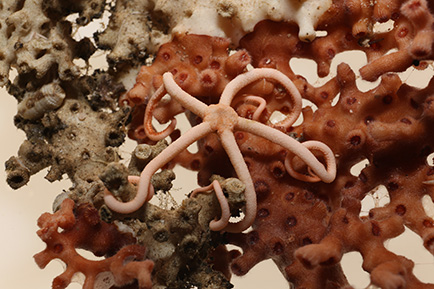Abstract
During the scientific expedition of the R/V Kexue in 2014, a new species belonging to the genus Astrocharis Koehler, 1904 was collected from a seamount near the Yap Trench. Astrocharis margarita sp. nov. is distinguished from the other species of Astrocharis by the following characters: radial shields are partly naked or completely covered by polygonal ossicles, and the body color is uniformly light pink. Maximum Likelihood Tree and Bayesian Tree, based on a concatenated dataset of COI, 16S, and 18S genes analyses, indicated that the monophyly of Astrocharis was not supported, which suggested the genus needs to be revised.
References
- Chen, W.Y., Na, J.Y. & Zhang, D.S. (2021) Description of three species of ophioplinthacids, including a new species, from a deep seamount in the Northwest Pacific Ocean. PeerJ, (9), e11566. https://doi.org/10.7717/peerj.11566 DOI: https://doi.org/10.7717/peerj.11566
- Gray, J.E. (1840) Room II. In: Synopsis of the contents of the British Museum, Edition 42, London. pp. 57–65.
- Hugall, A.F., O’Hara, T.D., Hunjan, S., Nilsen, R. & Moussalli, A. (2016) An Exon-Capture System for the Entire Class Ophiuroidea. Molecular Biology and Evolution, 33 (1), 281–294. https://doi.org/10.1093/molbev/msv216 DOI: https://doi.org/10.1093/molbev/msv216
- Kalyaanamoorthy, S., Minh, B.Q., Wong, T.K.F., von Haeseler, A. & Jermiin, L.S. (2017) ModelFinder: fast model selection for accurate phylogenetic estimates. Nature Methods, 14 (6), 587–589. https://doi.org/10.1038/nmeth.4285 DOI: https://doi.org/10.1038/nmeth.4285
- Katoh, K. & Standley, D.M. (2013) MAFFT Multiple Sequence Alignment Software Version 7: Improvements in Performance and Usability. Molecular Biology and Evolution, 30 (4), 772–780. https://doi.org/10.1093/molbev/mst010 DOI: https://doi.org/10.1093/molbev/mst010
- Kimura, M. (1980) A simple method of estimating evolutionary rate of base substitutions through comparative studies of nucleotide sequences. Journal of Molecular Evolution, 16:111–120. https://doi.org/10.1007/BF01731581 DOI: https://doi.org/10.1007/BF01731581
- Koehler, R. (1904) Ophiures de l'expédition du Siboga. Part 1. Ophiures de mer profonde.In: Weber, Siboga Expeditie. M.E.J. Brill, Leiden, 45a, 1–176. https://doi.org/10.5962/bhl.title.11682 DOI: https://doi.org/10.5962/bhl.title.11682
- Lamarck, J.P.B.A. (1816) Histoire naturelle des Animaux sans veretèbres. Edition 1, Paris 2, 522–568 pp.
- Matsumoto, H. (1911) About Japanese Euryalidae. Dobutsugaku Zasshi Tokyo. Zoological Magazine, 23 (277), 617–631. https://doi.org/10.4044/joma1889.23.258_631 DOI: https://doi.org/10.4044/joma1889.23.258_631
- Mortensen, T. & Stephenson, K. (1918) Papers from Dr. Th. Mortensen Pacific Expedition 1914-16 - On a gall-producing parasitic Copepod infesting an Ophiurid. Videnskabelige Meddelelser fra Dansk Naturhistorisk Forening, 69, 245–297.
- McKnight, D.G. (2000) The marine fauna of New Zealand : basket-stars and snake-stars (Echinodermata : Ophiuroidea : Euryalinida). In: Donald, G. (Ed.), NIWA Biodiverisity Memior 115. National Institute of Water and Atmospheric Research, McKnight-Wellington, 5–79 pp.
- Nethupul, H., Stöhr, S. & Zhang, H.B. (2022) New species, redescriptions and new records of deep-sea brittle stars (Echinodermata: Ophiuroidea) from the South China Sea, an integrated morphological and molecular approach. European Journal of Taxonomy, 810, 1–95. https://doi.org/10.5852/ejt.2022.810.1723 DOI: https://doi.org/10.5852/ejt.2022.810.1723
- Nethupul, H., Stöhr, S. & Zhang, H.B. (2022) Order Euryalida (Echinodermata, Ophiuroidea), new species and new records from the South China Sea and the Northwest Pacific seamounts. ZooKeys, 1090, 161–216. https://doi.org/10.3897/zookeys.1090.76292 DOI: https://doi.org/10.3897/zookeys.1090.76292.figure10
- O’Hara, T.D. (2017) Ophiuroidea. In: Byrne, M. & O’Hara, T.D. (eds) Australian Echinoderms: Biology, Ecology & Evoluion. CSIRO Publishing, Melbourne and ABRS, Canberra, xx + 612 pp.
- Okanishi, M. & Fujita, T. (2011) A Taxonomic Review of the Genus Astrocharis Koehler (Echinodermata: Ophiuroidea: Asteroschematidae), with a Description of a New Species. Zoological Science, 28 (2), 148–157. https://doi.org/10.2108/zsj.28.148 DOI: https://doi.org/10.2108/zsj.28.148
- Okanishi, M. & Fujita, T. (2013) Molecular phylogeny based on increased number of species and genes revealed more robust family-level systematics of the order Euryalida (Echinodermata: Ophiuroidea). Molecular Phylogenetics and Evolution, 69 (3), 566–580. https://doi.org/10.1016/j.ympev.2013.07.021 DOI: https://doi.org/10.1016/j.ympev.2013.07.021
- Okanishi, M., O’Hara, T.D. & Fujita, T. (2011a) Molecular phylogeny of the order Euryalida (Echinodermata: Ophiuroidea), based on mitochondrial and nuclear ribosomal genes. Molecular Phylogenetics and Evolution, 61 (2), 392–399. https://doi.org/10.1016/j.ympev.2011.07.003 DOI: https://doi.org/10.1016/j.ympev.2011.07.003
- Okanishi, M., O’Hara, T.D. & Fujita, T. (2011b) A new genus Squamophis of Asteroschematidae (Echinodermata, Ophiuroidea, Euryalida) from Australia. ZooKeys, 129, 1–15. https://doi.org/10.3897/zookeys.129.1202 DOI: https://doi.org/10.3897/zookeys.129.1202
- Palumbi, S.R. (1996) Nucleic Acids II: The polymerase chain Reaction [M].: Sinauer Associates, Sunderland, 205–247 pp.
- Steel, D., Stewart, B., Trewick, S. & Wallis, G. (2015) Fiord populations of Astrobrachion constrictum (Ophiuroidea: Asteroschematidae) show little genetic differentiation for mitochondrial DNA. New Zealand Journal of Zoology, 42 (3), 165–172. https://doi.org/10.1080/03014223.2015.1059863 DOI: https://doi.org/10.1080/03014223.2015.1059863
- Stöhr, S., O’Hara, T.D. & Thuy, B. (2012) Global diversity of brittle stars (Echinodermata: Ophiuroidea). PLoS ONE, 7, e31940. https://doi.org/10.1371/journal.pone.0031940. DOI: https://doi.org/10.1371/journal.pone.0031940
- Stöhr, S., O’Hara, T.D. & Thuy, B. [Eds] (2023) The World Ophiuroidea Database. Available from: http://www.marinespecies.org/ophiuroidea (Accessed 7 September 2021) https://doi.org/10.14284/358
- Tamura, K., Stecher, G., Peterson, D., Filipski, A. & Kumar, S. (2013) MEGA6: Molecular Evolutionary Genetics Analysis Version 6.0. Molecular Biology and Evolution, 30 (12), 2725–2729. https://doi.org/10.1093/molbev/mst197 DOI: https://doi.org/10.1093/molbev/mst197
- Ronquist, F. & Huelsenbeck, J.P. (2003) MrBayes 3: Bayesian phylogenetic inference under mixed models. Bioinformatics, 19 (12), 1572–1574. https://doi.org/10.1093/bioinformatics/btg180 DOI: https://doi.org/10.1093/bioinformatics/btg180


